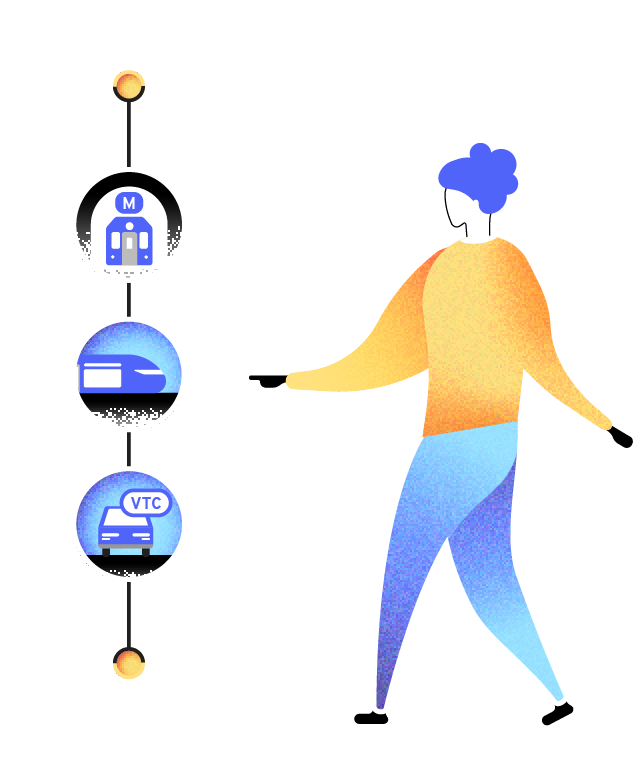Real travel assistants, mobility applications have as their main mission to guide the user in the best possible way. In particular, by including on a single platform the planning of trips, or even the reservation of a myriad of public and private transport modes with the so-called MaaS solutions. According to a Juniper Research study, MaaS solution can save up to 90 hours per year. Better routing, shorter commute… Couldn’t we go even further? In this article, discover in which use case Machine Learning is perfectly suited to trip planning…

The Learning Machine in a few words
A sub-branch of a concept that has been known for years, Machine Learning is partly based on Artificial Intelligence (AI). First used by Arthur Samuel, pioneer of AI in 1959, Machine Learning is the ability of a machine to learn by itself. And without programming it explicitly.
This is notably the case in facial recognition programs for example. Due to the complexity of the input data, this type of program would only be possible by recovering the pixels of each face. And then comparing them to different models. You can imagine the volume of lines of code needed for such a program. At first glance, a program impossible to develop, but which the engineers have managed to do. And this, thanks to the Machine Learning based on statistics and mathematics.
A concept that is revolutionizing many sectors today. Such as health via programs capable of detecting cancer cells. Or the aerospace industry, the biomechanical industry, and of course the tourism industry.
In the MaaS and intermodality Era, Machine Learning is now seen as a solution that can make mobility platforms even more intelligent. This is particularly true for journey planners. Making it more flexible based on different prediction factors. Factors that we have decided to split into 3 parts. Namely: the user profile, the environment, and finally the context of use.
1. Plan a trip according to the user’s profile
And if the best route was not only the duration with the shortest route. But also to the most pleasant? A problem that Machine Learning could solve. In particular, by personalizing the customer experience as much as possible. But how? To answer this question, let’s take the example of three friends, Thibault Alex & Roxanne. We are no longer in a COVID-19 period, and they have decided to meet in a downtown café. As usual, when they come back home, they all use the same mobile application to plan their own itinerary.

On the side of Matthieu, the app purpose him a trip by walk. A great sportsman, he is not disturbed at the idea of being home in 28 minutes. A travel time probably longer but allowing him to save the travel cost. On the contrary, for Alex, the application purpose him a bus trip as a first choice. Because he is more sensitive to the comfort of his journey. A desire also shared by Roxanne. But knowing that she doesn’t like public transportation, the application then offered her a taxi as first option.
2. Plan an itinerary according to the environment
And what if, in addition to analyzing our users’ profiles, our route planner was also based on the environment? Currently, some applications are able to inform about the state of road traffic. But imagine for a moment bringing other parameters such as the weather into play. Data from different APIs such as Météo Concept, OpenWeatherMap, DarkSky, or WeatherStack. Or air pollution data from organizations such as Atmo, IQAir, or OpenAQ. By adding this type of data, any trip calculator would go one level higher.
Let’s take the case of our 3 friends presented above. When searching for their itineraries, the application informs them that during the trip, there is a good chance that it will start raining. A forecast signaled earlier to Thibault, who thus decided to finally take the bus.
Another even more revealing case with Roxanne. She is used every evening to follow her soap opera at 7pm. Having chosen to opt for the VTC, she is finally blocking on the road. This is something that can be predicted with the Machine Learning, allowing Roxanne to use another, faster mode of transportation.

3. Plan a trip according to the context
By context, we mean under what circumstances, for what reason the application is used. Let’s take the example of our 3 friends, to illustrate this last criterion. As sportsman, Thibault often uses the application after his session at the gym. Usually, the application offers him an intermodal route combining the bus followed by a 15-minute walk. Not always obvious after running 20 kilometers on the treadmill. A physical condition and level of fatigue that can be predicted by the Machine Learning.
And we can go even further with Alex. Indeed, every 3 weeks he is used to doing big food runs. And who says big errands, necessarily means several bags to carry. Not always obvious on the bus and even more so if there are several connections. This is information that Machine Learning could have predicted beforehand and thus propose the least “restrictive” route.
Promote the use of free-floating operators
One of the main expectations of MaaS is to promote more sustainable modes of transportation. In particular with free-floating operators. Unlike other means of transportation, the latter are free-floating. This model sometimes makes it difficult to plan intermodal trips.
Take the case of Alex who decides to choose an intermodal route that includes a metro ride + scooter. Three stations and a few minutes by walk, no scooter is available. Forced to continue on foot, he arrives at work more than 15 minutes late.
In fact, between the stage of looking for a route and unlocking the scooter or bicycle, it can take several minutes. A problem that can be solved using Machine Learning, particularly with the help of the usage data of free-floating operators. Information that can allow the Machine Learning to make predictions about usage scenarios in a given geographical area. Enough to guarantee availability!





